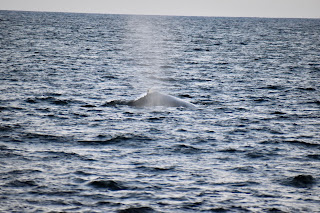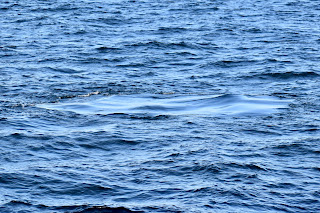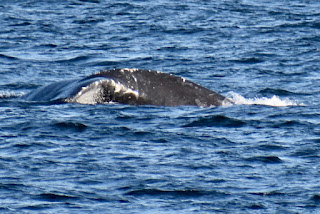Cape May pelagic
This past Friday I went on a 12-hour birding and marine life pelagic boat trip out of Cape May. I was hoping to see jaegers (parasitic or possibly a pomarine), a couple different shearwaters or some other surprise birds. Unfortunately, the only truly pelagic birds seen on the trip were some northern gannets, and they were on the inshore portion of the trip. The only surprise birds we saw offshore were a couple of yellow-rumped warblers and a blackpoll warbler about 50 miles out. As it turned out, they were the only birds we saw that far out.
The trip, however, was salvaged by the whales we encountered on our way out and on our return to inshore waters. In all, we saw seven humpback whales and a rarely encountered North Atlantic right whale. On the way out, one of the humpback whales was very accommodating. For what seemed like over a half hour, it surfaced time after time near the boat. After surfacing and diving along one side of the boat, it would re-emerge on the other side. When it dove again, watchers stood at the ready with cameras for it to pop up again, but not sure where exactly. It surfaced at the front of the boat, at the rear and the sides. Sometimes it was close enough to hear it expel the air from its blow hole. Melissa, one of the naturalists on board, said this behavior is called mugging, when a whale stays close to a vessel. A captain trained in proper whale watching will not move his boat until the whale moves itself a safe distance away.
Whale researchers use photos of the mammals' flukes, along with body markings and scars to help identify individual whales. Each whale's fluke has a unique pattern of color, scarring and ridges much like a human fingerprint. Researchers maintain a database of whales and use it to follow their encounters and migration patterns. Melissa was able to identify one of the whales nicknamed Binary. When I looked at my photos of Binary's fluke, I recognized it too. I remembered the little round circle on it that looked like a tattoo. My wife and I saw this same whale last year on a trip with the other whale watching outfit in Cape May.
On our return we were watching a humpback whale when the naturalists grew excited after another whale surfaced and dove in the area. They were sure they had spotted a North Atlantic right whale. The blow spout of a right whale is distinctive with a split as in a V pattern. Humpback whale blow spouts are in a solid column. Also, a right whale does not have a dorsal fin, the fin on top of its back. The captain stopped the vessel and everyone on board scanned the ocean all around the boat, patiently waiting for it to resurface. When it finally did, the excited crew confirmed it as a right whale. According to them, this species of whale is critically endangered with an estimated population of only around 350 individuals. Captain Matt explained the rarity of seeing a right whale by saying that since 2012, this was only the third right whale sighting for the crew. How lucky am I? Well, I was aboard the boat for their second sighting on March 21 last year. In fact, that encounter was of a mother and her calf just hanging out only a few miles the beach.
Because of its endangered status, vessels are not permitted to approach within 500 yards of a North Atlantic right whale. Before it eventually swam off from us, the whale gave great views, including a partial breach that caught everyone off guard, lifting its whole head out of the water. Not nearly as acrobatic as humpback whales, the face and tail of right whales often are not seen. This whale showed us both, raisings its fluke on a couple deep dives. Right whale individuals are identified by the white bumps on the top of their heads called callosities. Callosities look like barnacles but according to the Anderson Cabot Center for Ocean Life website, the callosities are raised tissue the same color as the whale's skin. The callosities are covered with a lighter colored whale lice that make them appear white.























Comments
Post a Comment